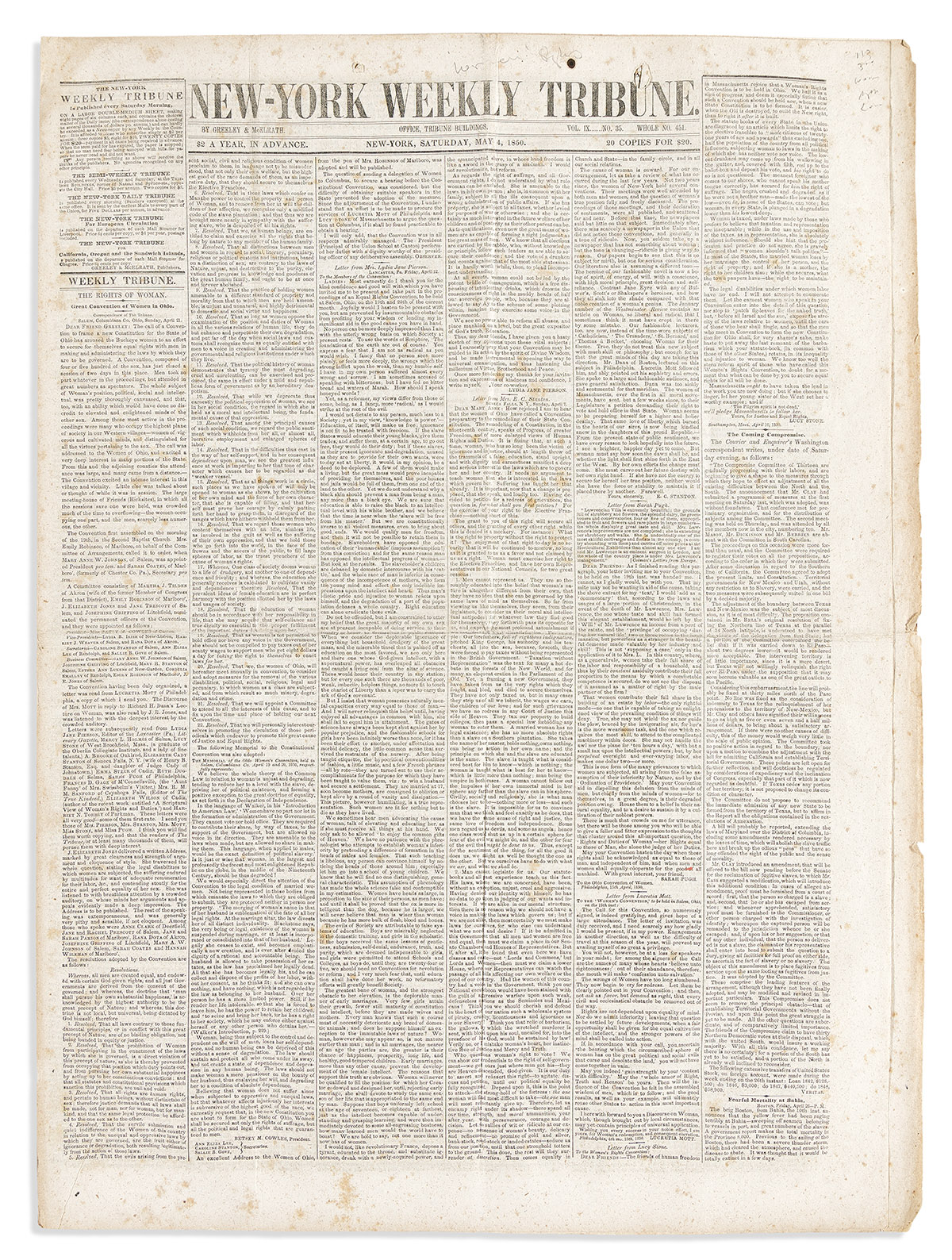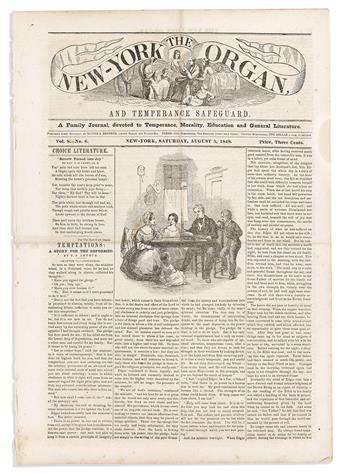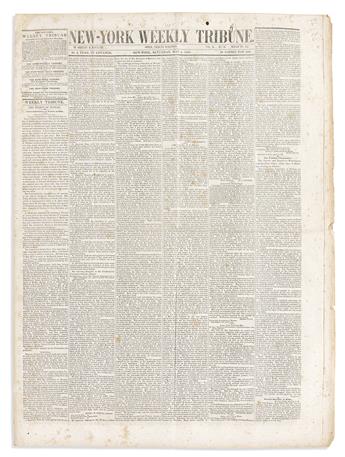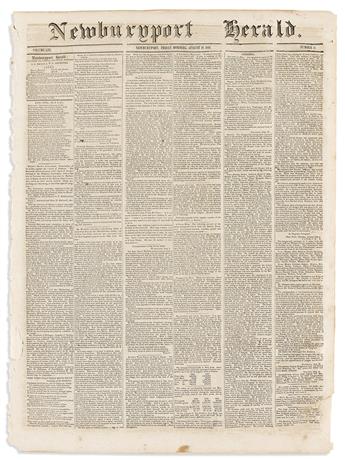Sale 2639 - Lot 140
Price Realized: $ 4,000
Price Realized: $ 5,000
?Final Price Realized includes Buyer’s Premium added to Hammer Price
Estimate: $ 500 - $ 700
Seneca Falls & Ohio Women's Rights Conventions.
Three Contemporary Newspaper Reports, 1848-1850.
Including:
1) The Newburyport Herald, August 18, 1848, issue carrying a long report on the convention held on July 19th and 20th as reported in the Rochester Advertiser; two leaves; marginal tears, not affecting the text, 24 x 17 1/2 in.
In addition to writing of Frederick Douglass's presence at and contributions to the convention, the reporter also notes the difficulty women encountered procuring a venue to meet. Lucretia Mott noted that when the Female Reform Society of Philadelphia asked to host meetings its meetings at a church in the city, "they were allowed to use the basement of the church, on condition that none of the women should speak at the meeting." After a speech by a Mr. William C. Nell in lavish praise of women, Mott "took some exceptions." "She said that man was not by nature a tyrant, but had been made tyrannical by the power which had by general consent been conferred upon him. She merely wished that woman might be entitled to equal rights, and acknowledged as the equal of man, not his superior."
2) New York Weekly Tribune, May 4, 1850 issue, containing an extensive five-and-a-half-column full-page story about the convention, with its twenty-two resolutions printed in full, along with a narrative describing its leaders, a strongly worded statement focused on women's lack of human rights under the law written by Convention President Betsey Mix Cowles; along with letters in support of the cause by activists unable to attend by Lydia Jane Pierson, Elizabeth Cady Stanton, Sarah Pugh, Lucretia Mott, and Lucy Stone; old folds, some foxing, eight pages, uncut at the top, 21 x 15 1/2 in.
Notice of the third women's rights convention held in the U.S., and the first held outside of New York state held particular interest for readers of a New York paper. As a statewide convention, it drew more than 500 Ohioans and did not allow men to vote, speak, or attend as anything other than spectators. "The call of a Convention to frame a new Constitution for the State of Ohio has aroused the Buckeye women to an effort to secure for themselves equal rights with men in making and administering the laws by which they are to be governed."
3) The New York Organ and Temperance Safeguard,, August 5, 1848, tabloid-format newspaper consisting of pages 41-48, a complete issue, containing notice of the recent convention (page 45, fourth column), which may be read as mocking or tongue-in-cheek support, in full below, 15 x 10 1/2 in.
"Woman's Rights.--- A Convention has recently been held in the village of Seneca Falls, at which the present civil, social, and religious condition of woman was the subject of consideration. A declaration of independence, amended from that of revolutionary memory, was presented and adopted. Its fundamental position was improved so as to read: 'We hold these truths to be self-evident, that all men and women are created equal.' Women equal to us! Prepos-terious! Verily some men have long imagined that they owned the women; but now these are going to rebel against our government and set up equality! What is the world coming to!"
Three Contemporary Newspaper Reports, 1848-1850.
Including:
1) The Newburyport Herald, August 18, 1848, issue carrying a long report on the convention held on July 19th and 20th as reported in the Rochester Advertiser; two leaves; marginal tears, not affecting the text, 24 x 17 1/2 in.
In addition to writing of Frederick Douglass's presence at and contributions to the convention, the reporter also notes the difficulty women encountered procuring a venue to meet. Lucretia Mott noted that when the Female Reform Society of Philadelphia asked to host meetings its meetings at a church in the city, "they were allowed to use the basement of the church, on condition that none of the women should speak at the meeting." After a speech by a Mr. William C. Nell in lavish praise of women, Mott "took some exceptions." "She said that man was not by nature a tyrant, but had been made tyrannical by the power which had by general consent been conferred upon him. She merely wished that woman might be entitled to equal rights, and acknowledged as the equal of man, not his superior."
2) New York Weekly Tribune, May 4, 1850 issue, containing an extensive five-and-a-half-column full-page story about the convention, with its twenty-two resolutions printed in full, along with a narrative describing its leaders, a strongly worded statement focused on women's lack of human rights under the law written by Convention President Betsey Mix Cowles; along with letters in support of the cause by activists unable to attend by Lydia Jane Pierson, Elizabeth Cady Stanton, Sarah Pugh, Lucretia Mott, and Lucy Stone; old folds, some foxing, eight pages, uncut at the top, 21 x 15 1/2 in.
Notice of the third women's rights convention held in the U.S., and the first held outside of New York state held particular interest for readers of a New York paper. As a statewide convention, it drew more than 500 Ohioans and did not allow men to vote, speak, or attend as anything other than spectators. "The call of a Convention to frame a new Constitution for the State of Ohio has aroused the Buckeye women to an effort to secure for themselves equal rights with men in making and administering the laws by which they are to be governed."
3) The New York Organ and Temperance Safeguard,, August 5, 1848, tabloid-format newspaper consisting of pages 41-48, a complete issue, containing notice of the recent convention (page 45, fourth column), which may be read as mocking or tongue-in-cheek support, in full below, 15 x 10 1/2 in.
"Woman's Rights.--- A Convention has recently been held in the village of Seneca Falls, at which the present civil, social, and religious condition of woman was the subject of consideration. A declaration of independence, amended from that of revolutionary memory, was presented and adopted. Its fundamental position was improved so as to read: 'We hold these truths to be self-evident, that all men and women are created equal.' Women equal to us! Prepos-terious! Verily some men have long imagined that they owned the women; but now these are going to rebel against our government and set up equality! What is the world coming to!"
Exhibition Hours
Exhibition Hours
Aliquam vulputate ornare congue. Vestibulum maximus, libero in placerat faucibus, risus nisl molestie massa, ut maximus metus lectus vel lorem.








